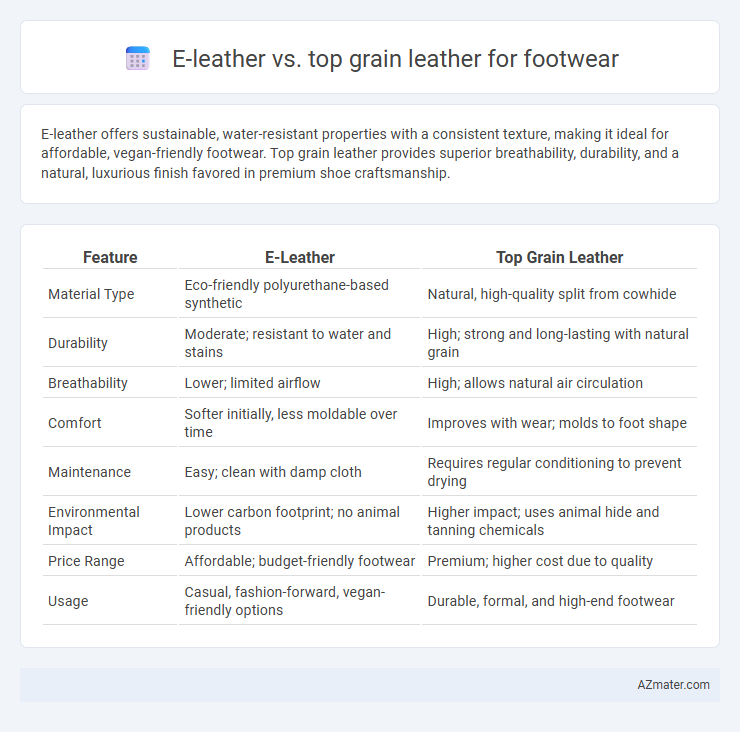E-leather offers sustainable, water-resistant properties with a consistent texture, making it ideal for affordable, vegan-friendly footwear. Top grain leather provides superior breathability, durability, and a natural, luxurious finish favored in premium shoe craftsmanship.
Table of Comparison
| Feature | E-Leather | Top Grain Leather |
|---|---|---|
| Material Type | Eco-friendly polyurethane-based synthetic | Natural, high-quality split from cowhide |
| Durability | Moderate; resistant to water and stains | High; strong and long-lasting with natural grain |
| Breathability | Lower; limited airflow | High; allows natural air circulation |
| Comfort | Softer initially, less moldable over time | Improves with wear; molds to foot shape |
| Maintenance | Easy; clean with damp cloth | Requires regular conditioning to prevent drying |
| Environmental Impact | Lower carbon footprint; no animal products | Higher impact; uses animal hide and tanning chemicals |
| Price Range | Affordable; budget-friendly footwear | Premium; higher cost due to quality |
| Usage | Casual, fashion-forward, vegan-friendly options | Durable, formal, and high-end footwear |
Introduction to E-Leather and Top Grain Leather
E-leather, also known as eco-friendly or engineered leather, is crafted using sustainable materials and innovative techniques to mimic the texture and durability of traditional leather while reducing environmental impact. Top grain leather, derived from the upper layer of animal hide, is prized for its strength, natural grain, and breathability, making it a premium choice for high-quality footwear. Comparing E-leather and top grain leather highlights key differences in texture, durability, sustainability, and maintenance, influencing consumer preferences in the footwear industry.
Material Composition and Manufacturing Process
E-leather for footwear is primarily composed of a biodegradable polyurethane blend with natural fibers, offering a sustainable alternative to traditional leather. Top grain leather undergoes a meticulous process of sanding and buffing the outer layer of animal hides, enhancing durability and breathability. The manufacturing of e-leather involves advanced bio-polymer synthesis and eco-friendly coating techniques, while top grain leather requires tanning, dyeing, and finishing processes derived from animal hides.
Durability and Longevity Comparison
Top grain leather offers superior durability and longevity for footwear due to its natural fiber structure and resistance to wear and tear. E-leather, made from engineered materials, tends to have lower breathability and may degrade faster under constant flexing and moisture exposure. Choosing top grain leather ensures extended lifespan and better performance in high-stress footwear environments.
Comfort and Breathability in Footwear
E-leather offers enhanced breathability compared to traditional top grain leather, making it a popular choice for footwear focused on all-day comfort and moisture management. Its synthetic composition allows for better air circulation, reducing heat buildup and sweat accumulation during wear. Conversely, top grain leather provides natural durability and a soft, conforming fit but may require treatments to improve its breathability for optimal comfort.
Environmental Impact and Sustainability
E-leather, produced from recycled materials such as polyurethane and plant-based fibers, significantly reduces environmental pollution compared to top grain leather, which relies on animal hides and intensive tanning processes emitting harmful chemicals. Top grain leather involves resource-heavy livestock farming, contributing to deforestation, greenhouse gas emissions, and high water consumption, whereas E-leather manufacturing generally has a lower carbon footprint and minimizes water usage. Choosing E-leather for footwear supports sustainability goals by promoting waste reduction and decreasing reliance on finite natural resources.
Cost and Price Considerations
E-leather typically costs 20-40% less than top grain leather, making it a budget-friendly option for footwear manufacturers targeting affordability without sacrificing appearance. Top grain leather, derived from the second layer of the hide, commands higher prices due to its durability, natural texture, and premium quality, often reflected in retail prices that can be double or more compared to e-leather shoes. Cost-sensitive consumers may prefer e-leather footwear for its lower price point and ethical appeal, while those prioritizing longevity and luxury often invest in top grain leather products despite the higher initial expense.
Aesthetic Appeal and Design Versatility
E-leather offers consistent texture and vibrant color options, making it ideal for bold and trendy footwear designs. Top grain leather boasts natural grain patterns and a luxurious patina that enhances the aesthetic appeal of classic and premium shoes. Design versatility favors e-leather for customization and innovative cuts, while top grain leather excels in durability and timeless elegance.
Maintenance and Care Requirements
E-leather footwear requires minimal maintenance due to its synthetic composition, needing only regular cleaning with a damp cloth and avoidance of excessive heat to prevent damage. Top grain leather demands more intensive care, including periodic conditioning with leather oils or creams to maintain suppleness and prevent cracking, alongside protection from moisture and direct sunlight. Understanding these differences ensures durability and longevity tailored to the specific material in footwear.
Performance in Different Weather Conditions
E-leather exhibits superior water resistance and maintains flexibility in humid and rainy weather, making it ideal for urban environments with frequent moisture exposure. Top grain leather excels in breathability and temperature regulation, providing comfort in hot and dry conditions but requiring proper maintenance to prevent cracking in extreme cold. Both materials offer durable performance; however, E-leather requires less upkeep in wet climates, whereas top grain leather outperforms in longevity and natural aging under variable weather conditions.
Choosing the Right Leather for Your Footwear
Top grain leather, known for its durability and natural breathability, offers a premium feel and long-lasting comfort in footwear. E-leather, made from engineered materials, provides a more affordable, eco-friendly alternative with consistent texture and easier maintenance. Choosing the right leather depends on priorities like budget, sustainability, and desired durability for everyday wear.

Infographic: E-leather vs Top grain leather for Footwear
 azmater.com
azmater.com